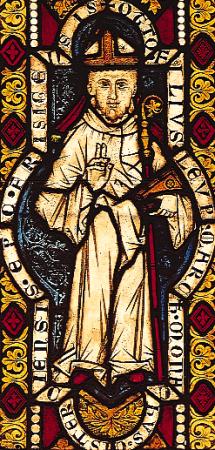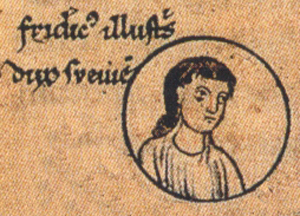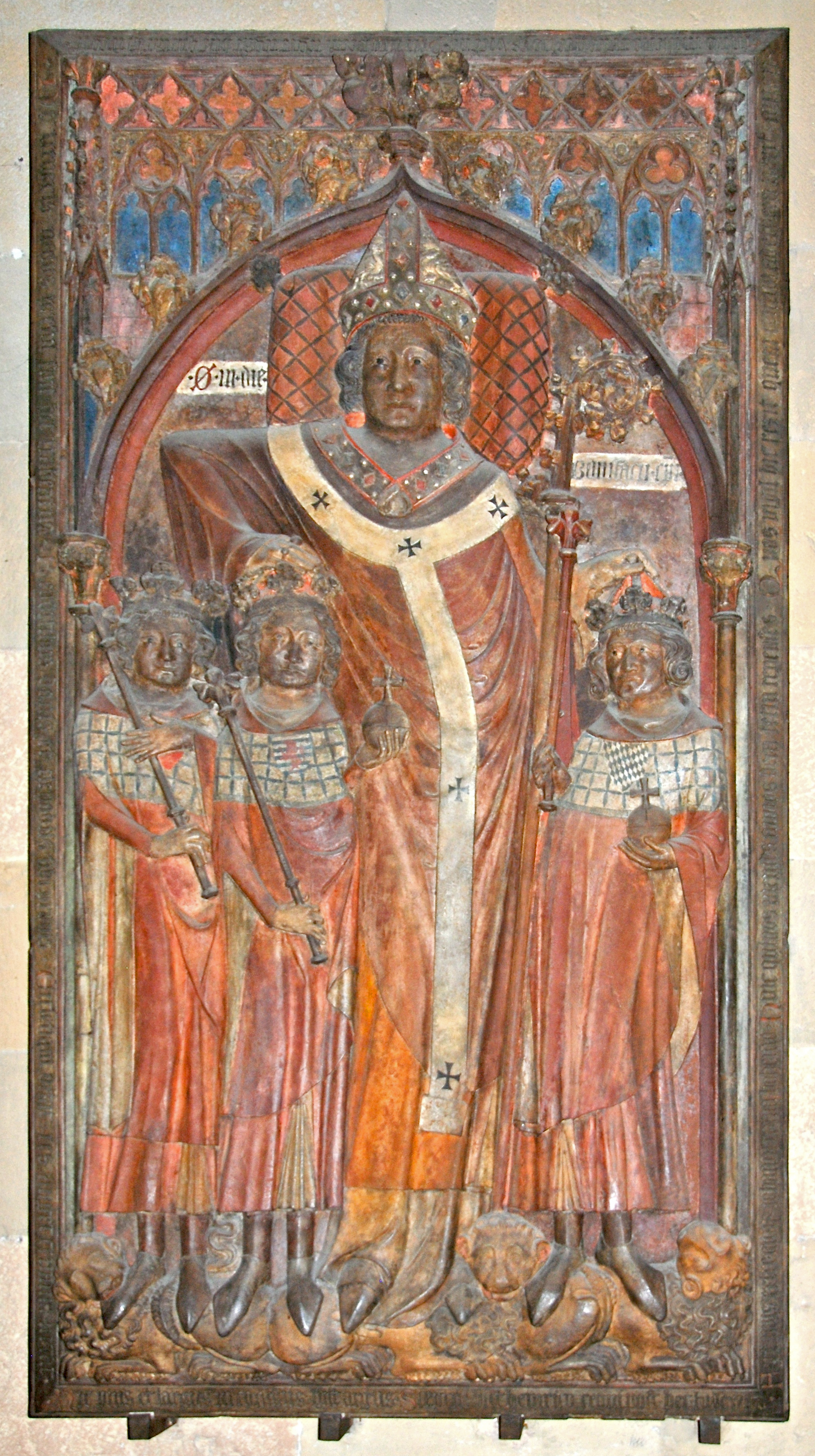|
Henry I (Archbishop Of Mainz)
Henry, in German Heinrich (c. 1080 – 1/3 September 1153), was the archbishop of Mainz from September 1142 until his deposition in June 1153. Early life The future archbishop may be the same person as the Henry who is recorded as archdeacon of the collegiate church of Marienkamp in Mainz in 1104. The prologue of one late 12th-century copy of the ''Imago mundi'' of Honorius of Autun says that the text was edited by this Henry in 1110. As a result, Henry has often been associated with the accompanying ''mappa mundi'', the Sawley map, but there is no basis for connecting the editor of the text with later addition of a map. A canon named Henry is also recorded attached to Mainz Cathedral in 1111.. Archbishop Henry succeeded Markholf as archbishop of Mainz in September 1142. In his early years as archbishop he was assisted by Anselm of Havelberg. He was a supporter and correspondent of Hildegard of Bingen. In 1147, at the synod of Trier, he presented a copy of Hildegard's biblical ... [...More Info...] [...Related Items...] OR: [Wikipedia] [Google] [Baidu] |
Catholic Church
The Catholic Church, also known as the Roman Catholic Church, is the largest Christian church, with 1.3 billion baptized Catholics worldwide . It is among the world's oldest and largest international institutions, and has played a prominent role in the history and development of Western civilization.O'Collins, p. v (preface). The church consists of 24 ''sui iuris'' churches, including the Latin Church and 23 Eastern Catholic Churches, which comprise almost 3,500 dioceses and eparchies located around the world. The pope, who is the bishop of Rome, is the chief pastor of the church. The bishopric of Rome, known as the Holy See, is the central governing authority of the church. The administrative body of the Holy See, the Roman Curia, has its principal offices in Vatican City, a small enclave of the Italian city of Rome, of which the pope is head of state. The core beliefs of Catholicism are found in the Nicene Creed. The Catholic Church teaches that it is the on ... [...More Info...] [...Related Items...] OR: [Wikipedia] [Google] [Baidu] |
Second Crusade
The Second Crusade (1145–1149) was the second major crusade launched from Europe. The Second Crusade was started in response to the fall of the County of Edessa in 1144 to the forces of Zengi. The county had been founded during the First Crusade (1096–1099) by King Baldwin I of Jerusalem in 1098. While it was the first Crusader state to be founded, it was also the first to fall. The Second Crusade was announced by Pope Eugene III, and was the first of the crusades to be led by European kings, namely Louis VII of France and Conrad III of Germany, with help from a number of other European nobles. The armies of the two kings marched separately across Europe. After crossing Byzantine territory into Anatolia, both armies were separately defeated by the Seljuk Turks. The main Western Christian source, Odo of Deuil, and Syriac Christian sources claim that the Byzantine Emperor Manuel I Komnenos secretly hindered the crusaders' progress, particularly in Anatolia, where he is allege ... [...More Info...] [...Related Items...] OR: [Wikipedia] [Google] [Baidu] |
Einbeck
Einbeck (; Eastphalian: ''Aimbeck'') is a town in the district Northeim, in southern Lower Saxony, Germany, on the German Timber-Frame Road. History Prehistory The area of the current city of Einbeck is inhabited since prehistoric times. Various artifacts have been unearthed in the city of Einbeck itself and in the little villages and lost villages around it over the years. They date back to the Paleolithic Era. Medieval period In the Early Middle Ages a number of villages existed along the river Ilme in the middle Leine valley before Einbeck was founded. On January 1, 1158 Einbeck was first mentioned in a deed of Friedrich Barbarossa, which mentioned ''… in loco qui Einbike vocatur …''. and related to a transfer of an estate in the 11th century. Count Udo of Katlenburg owned an estate on the bank of a brook, the Krummes Wasser (crooked water). His grandson founded the stift Sankt Alexandri, that subsequently developed into an important sanctuary. On the other side of th ... [...More Info...] [...Related Items...] OR: [Wikipedia] [Google] [Baidu] |
Otto Of Freising
Otto of Freising ( la, Otto Frisingensis; c. 1114 – 22 September 1158) was a German churchman of the Cistercian order and chronicled at least two texts which carries valuable information on the political history of his own time. He was Otto I Bishop of Freising as from 1138. Otto participated in the Second Crusade; he lived through the journey and reached Jerusalem, and later returned to Bavaria in the late 1140s, living for another decade back in Europe. Life Otto was born in Klosterneuburg as the fifth son of Leopold III, margrave of Austria, by his wife Agnes, daughter of the emperor Henry IV. By her first husband, Frederick I of Hohenstaufen, duke of Swabia, Agnes was the mother of the German king Conrad III and grandmother of the emperor Frederick I. Otto's sister, Judith or Ita, was married to Marquess William V of Montferrat. Otto was thus related to the most powerful families in Germany and northern Italy. The records of his life are scanty and the dates somewha ... [...More Info...] [...Related Items...] OR: [Wikipedia] [Google] [Baidu] |
Worms, Germany
Worms () is a city in Rhineland-Palatinate, Germany, situated on the Upper Rhine about south-southwest of Frankfurt am Main. It had about 82,000 inhabitants . A pre-Roman foundation, Worms is one of the oldest cities in northern Europe. It was the capital of the Kingdom of the Burgundians in the early fifth century, hence is the scene of the medieval legends referring to this period, notably the first part of the ''Nibelungenlied''. Worms has been a Roman Catholic bishopric since at least 614, and was an important palatinate of Charlemagne. Worms Cathedral is one of the imperial cathedrals and among the finest examples of Romanesque architecture in Germany. Worms prospered in the High Middle Ages as an imperial free city. Among more than a hundred imperial diets held at Worms, the Diet of 1521 (commonly known as ''the'' Diet of Worms) ended with the Edict of Worms, in which Martin Luther was declared a heretic. Worms is also one of the historical ShUM-cities as a cultural ... [...More Info...] [...Related Items...] OR: [Wikipedia] [Google] [Baidu] |
Frederick IV, Duke Of Swabia
Frederick IV of Hohenstaufen (1145–1167) was duke of Swabia, succeeding his cousin, Frederick Barbarossa, Holy Roman Emperor, in 1152. He was the son of Conrad III of Germany and his second wife Gertrude von Sulzbach and thus the direct heir of the crown, had there been true heredity. However, on his death bed, Conrad III allegedly advised the only two persons present, his nephew Frederick Barbarossa and the bishop of Bamberg, to nominate Frederick Barbarossa; and handed the Imperial insignia to him. Barbarossa wasted no time in getting the Bavarian clerics to endorse him, and had the archbishop of Cologne convene a hurried election. There the electors of the Empire (minus their "''primus inter pares''", Henry I, Archbishop of Mainz, an ally of the Pope) elected Frederick Barbarossa to be King, instead of his six-year-old cousin Frederick. The younger man became Duke of Swabia instead. Frederick participated in Barbarossa's campaigns in Italy, becoming one of the many casualt ... [...More Info...] [...Related Items...] OR: [Wikipedia] [Google] [Baidu] |
Chronica Regia Coloniensis
The ''Chronica regia Coloniensis'' ("Royal Chronicle of Cologne", German: ''Kölner Königschronik''), also called the ''Annales Colonienses maximi'', is an anonymous medieval Latin chronicle that covers the years 576 to 1202. The original chronicle only went up to 1197, but a continuator later added the following few years' events. According to the historian Manfred Groten, the ''Chronica'' was probably first compiled about 1177 in Michaelsberg Abbey, Siegburg, and then continued in Cologne. The earliest manuscript only contains an account down to 1175. The chronicle is called "royal" because it is a history of the Roman emperors, Frankish kings, Byzantine emperors and German kings and emperors. It probably began with Augustus, but the beginning of the chronicle is lost. Up to 1106 the ''Chronica'' depends on the works of Frutolf von Michelsberg and Ekkehard of Aura, and then on until 1144 on the now lost ''Annales Patherbrunnenses''. After that it is an independent source. The ... [...More Info...] [...Related Items...] OR: [Wikipedia] [Google] [Baidu] |
Frederick Barbarossa
Frederick Barbarossa (December 1122 – 10 June 1190), also known as Frederick I (german: link=no, Friedrich I, it, Federico I), was the Holy Roman Emperor from 1155 until his death 35 years later. He was elected King of Germany in Frankfurt on 4 March 1152 and crowned in Aachen on 9 March 1152. He was crowned King of Italy on 24 April 1155 in Pavia and emperor by Pope Adrian IV on 18 June 1155 in Rome. Two years later, the term ' ("holy") first appeared in a document in connection with his empire. He was later formally crowned King of Burgundy, at Arles on 30 June 1178. He was named by the northern Italian cities which he attempted to rule: Barbarossa means "red beard" in Italian; in German, he was known as ', which means "Emperor Redbeard" in English. The prevalence of the Italian nickname, even in later German usage, reflects the centrality of the Italian campaigns to his career. Frederick was by inheritance Duke of Swabia (1147–1152, as Frederick III) before his i ... [...More Info...] [...Related Items...] OR: [Wikipedia] [Google] [Baidu] |
Conrad III Of Germany
Conrad III (german: Konrad; it, Corrado; 1093 or 1094 – 15 February 1152) of the Hohenstaufen dynasty was from 1116 to 1120 Duke of Franconia, from 1127 to 1135 anti-king of his predecessor Lothair III and from 1138 until his death in 1152 king in the Holy Roman Empire. He was the son of Duke Frederick I of Swabia and Agnes, a daughter of the Salian Emperor Henry IV. His reign saw the start of the conflicts between the Guelphs and Gibbelins. He was involved in the failed Second Crusade with Louis VII, where he would fight and lose at Doryleum and would later fall ill and return to Constantinople. After recuperating, he went to Jerusalem but would experience a string of failed sieges. Later returning from the Crusade, he was entangled in some conflicts with Welf VI's claim to the Duchy of Bavaria. On his deathbed, he designated his nephew Frederick Barbarossa as his successor instead of his son, Frederick. Descent The origin of the House of Hohenstaufen in th ... [...More Info...] [...Related Items...] OR: [Wikipedia] [Google] [Baidu] |
Kingdom Of Arles
The Kingdom of Burgundy, known from the 12th century as the Kingdom of Arles, also referred to in various context as Arelat, the Kingdom of Arles and Vienne, or Kingdom of Burgundy-Provence, was a realm established in 933 by the merger of the kingdoms of Upper and Lower Burgundy under King Rudolf II. It was incorporated into the Holy Roman Empire in 1033 and from then on was one of the empire's three constituent realms, together with the Kingdom of Germany and the Kingdom of Italy. By the mid-13th century at the latest, however, it had lost its concrete political relevance. Its territory stretched from the Mediterranean Sea to the High Rhine River in the north, roughly corresponding to the present-day French regions of Provence-Alpes-Côte d'Azur, Rhône-Alpes and Franche-Comté, as well as western Switzerland. Until 1032 it was ruled by independent kings of the Elder House of Welf.''The New Columbia Encyclopedia'' 1975, 150 Carolingian Burgundy Since the conquest of the First ... [...More Info...] [...Related Items...] OR: [Wikipedia] [Google] [Baidu] |
Kingdom Of Germany
The Kingdom of Germany or German Kingdom ( la, regnum Teutonicorum "kingdom of the Germans", "German kingdom", "kingdom of Germany") was the mostly Germanic-speaking East Frankish kingdom, which was formed by the Treaty of Verdun in 843, especially after the kingship passed from Frankish kings to the Saxon Ottonian dynasty in 919. The king was elected, initially by the rulers of the stem duchies, who generally chose one of their own. After 962, when Otto I was crowned emperor, East Francia formed the bulk of the Holy Roman Empire, which also included the Kingdom of Italy and, after 1032, the Kingdom of Burgundy. Like medieval England and medieval France, medieval Germany consolidated from a conglomerate of smaller tribes, nations or polities by the High Middle Ages. The term ''rex teutonicorum'' (" king of the Germans") first came into use in Italy around the year 1000. It was popularized by the chancery of Pope Gregory VII during the Investiture Controversy (late 11th centur ... [...More Info...] [...Related Items...] OR: [Wikipedia] [Google] [Baidu] |
Archchancellor
An archchancellor ( la, archicancellarius, german: Erzkanzler) or chief chancellor was a title given to the highest dignitary of the Holy Roman Empire, and also used occasionally during the Middle Ages to denote an official who supervised the work of chancellors or notaries. The Carolingian successors of Pepin the Short appointed chancellors over the whole Frankish realm in the ninth century. Hincmar refers to this official as a ''summus cancellarius'' in ''De ordine palatii et regni'' and an 864 charter of King Lothair I refers to Agilmar, Archbishop of Vienne, as archchancellor, a word which also begins appearing in chronicles about that time. The last Carolingian archchancellor in West Francia was Archbishop Adalberon of Reims (969-988), with the accession of Hugh Capet the office was replaced by a ''Chancelier de France''. At the court of Otto I, then King of Germany, the title seems to have been an appanage of the Archbishop of Mainz. After Otto had finally deposed King ... [...More Info...] [...Related Items...] OR: [Wikipedia] [Google] [Baidu] |
.jpg)







